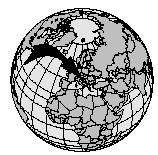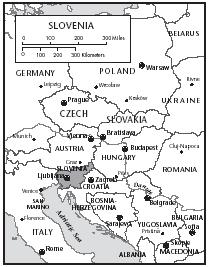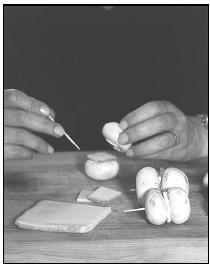Slovenia
Recipes

1 GEOGRAPHIC SETTING AND ENVIRONMENT
Slovenia is located in central Europe and shares boundaries with Austria (north), Hungary (east), Croatia (south), and Italy (west). It has a small coastal area in the southwest region, which borders the Adriatic Sea.
Next to Italy in the west are the Julian Alps and various mountains and valleys with numerous rivers in the east.
The climate in the coastal strip of Slovenia is determined by the Mediterranean Sea. Its inland climate ranges from mild to hot summers, with cold winters in the valleys and plateaus of the east.
2 HISTORY AND FOOD
From as early as the A.D. 800s, Slovenia has fallen under foreign control, gaining its independence only in 1991. For over 1,000 years, Slovenes lived mostly under German rule as part of the Holy Roman (962–1806), Austrian (1806–1867), and Austro-Hungarian (1867–1918) empires. World War II (1939–1945) divided present-day Slovenia among German, Italian, and Hungarian powers. Each of these countries, along with neighboring Austria to the north, has contributed significantly to Slovene cuisine.
German cuisine is typically heavy in meats and starches, which has carried over to Slovene cuisine. Germans relied on pork, sauerkraut, and potatoes for a majority of their dishes, as seen in present-day Slovene meals.
Austria, located north of present-day Slovenia, brought klobasa (a type of sausage), breaded, and pastry items, such as zavitek (strudels) to Slovene cooking.
Hungarian influences included golaz (goulash), paprikas (chicken or beef stew), and palacinke , which are thin pancakes filled with nuts or jam and topped with chocolate.
Italian pastas, such as njoki (potato dumplings), rizota (risotto), and zlikrofi , similar to ravioli, became part of the Slovene diet as well.

3 FOODS OF THE SLOVENES
Slovene cooking has over 30 different regional cuisines, influenced greatly by Slovenia's neighboring countries. While there is a sufficient amount of poultry, dairy products, and potatoes, much of the land in Slovenia is not suited for producing crops. Basic foods, such as oil, wheat, sugar, and meat are imported.
Slovene foods are often simple and hearty. Many dishes are made with cream, such as mushroom soup, and pork sour soup. Horseradish with cream, a specialty of northeastern Slovenia, is often served with beef dishes. Chicken paprika is a creamy sauce made with spicy, red paprika served over noodles or dumplings.
Golaz (Goulash)
Ingredients
- 3 Tablespoons vegetable oil
- 2 pounds beef stew meat
- 1 can beef broth
- 1 cup onion, chopped
- 2 Tablespoons tomato paste or ketchup
- 2 Tablespoons paprika
- ½ teaspoon salt
- ¼ teaspoon black pepper
- ⅓ cup water
- 3 Tablespoons flour
- 2 cups cooked egg noodles
Procedure
- In a large pot, heat the oil over medium heat. Add the beef and cook until sides are browned.
- Add beef broth, onion, tomato paste or ketchup, paprika, salt, and pepper.
- In a bowl, mix the water and flour, stirring to remove lumps. Stir the flour mixture into the pot with a wooden spoon.
- Cover and reduce heat to low. Simmer for 1 to 1½ hours, or until meat is tender; stir occasionally.
- Serve over hot noodles.
Makes 5 to 6 servings.
Breads and potatoes are the staple foods of Slovenia. Potica (po-TEET-sa) is the most common type of pastry—a nut roll wrapped around a variety of fillings, such as walnuts, hazelnuts, or raisins. Potatoes are served boiled, sautéed, deep-fried, or roasted. They are used in such dishes as fruit dumplings, soups, and stews, such as jota (a hearty meat and vegetable stew). Mushrooms are a large part of Slovene cuisine, and picking wild mushrooms has become a popular occupation. In fact, the government had to pass a law limiting the amount of mushrooms picked to keep some species from becoming extinct.
Baked Mushrooms with Cheese
Ingredients
- 1 8-ounce container of mushrooms
- ¼ pound Muenster cheese, sliced
Procedure
- Preheat oven to 300°F.
- Wash the mushroom caps under running water, and remove the stems. Dry with paper towels.
- Cut the cheese into squares to fit between two mushroom caps.
- Make a "sandwich" of two mushroom caps with one square of sliced cheese between them.
- Secure with a toothpick, and place the mushrooms into greased pie plate or baking dish.
- Bake for about 10 minutes, or until the cheese melts.
- Serve warm or at room temperature.
Makes about 15 to 20 snacks (depending on the number of mushrooms in the package).
Deep-Fried Potatoes
Ingredients
- 2 large potatoes, thinly sliced
- ½ cup vegetable oil
- Salt and pepper, to taste

Procedure
- In a large skillet, heat the oil over high heat.
- Slowly add the potato slices and fry until golden brown. Be careful of the hot oil, as it may sizzle and spurt when the potatoes are added.
- Remove potato slices and drain on paper towels. Season with salt and pepper.
Serve with Klobasa and Kisdo Zelje (Sausage and Sauerkraut; see recipe) for a complete Slovene meal.
Serves 4.
Jota
Ingredients
- 1¾ cup sauerkraut, drained
- ¾ cup canned red kidney beans, drained
- 1½ cups potato, cut into chunks
- 1½ cups ham or pork
- 4 cups water
- 2 cloves garlic
- Salt and pepper, to taste
- 1 bay leaf
- 1 medium onion, chopped
- ¼ cup shortening
- 2 teaspoons flour
- ¾ cup sour cream
Procedure
- Fill a large pot with water, and bring to a boil. Add the sauerkraut, beans, potatoes, and meat. Cook until vegetables are tender, about 20 minutes.
- Add the garlic and bay leaf. Season with salt and pepper.
- In a frying pan, melt the shortening over medium heat. Sauté the onions, about 3 minutes.
- Add the flour and cook about 2 more minutes, stirring frequently.
- Add the onion and flour mixture to the stew. Stir and simmer over low heat for about 15 minutes.
- Just before serving, add the sour cream and stir. Heat over low heat for 2 to 3 minutes. Serve.
Serves 4 to 6.
Pork is the main meat eaten by a majority of Slovenes. Koline , the time in winter when pigs are slaughtered and a variety of pork products are prepared, is a major undertaking for Slovene farmers. Blood (or black) pudding is the name of a type of sausage made from a mixture of blood, intestines, millet (a type of grain), buckwheat porridge, and seasonings. Traditionally, neighbors exchanged this sausage with each other, since each farm family had its own unique recipe.
Other pork dishes are zelodec (filled pork stomach), air-dried pork leg called prsut , and klobasa (sausage). Slovenian kranjske klobasa has a distinctive flavor that comes from its seasoning of rosemary, thyme, and garlic. Klobasa and Kisod Zelje (sausage with sauerkraut) makes for a filling lunch or dinner.
Klobasa and Kisdo Zelje (Sausage and Sauerkraut)
Ingredients
- 4 large klobasa (sausage links)
- 2 cans sauerkraut
- 1 clove garlic, minced
- Salt and pepper, to taste
Procedure
- Heat a frying pan to medium heat and add the sausage. Cook until browned on all sides. Remove and drain on paper towel.
- Add the sauerkraut and garlic to the frying pan and cook over medium heat. Season with salt and pepper.
- Add the sausage and cover. Cook until sausage is thoroughly heated and cooked through, about 15 to 20 minutes.
Serves 4.
Although meat and starchy foods prevail in Slovene cooking, vegetables, especially cabbage, are used in various ways. Common cabbage dishes are sauerkraut, sweet-and-sour cabbage, and raw cabbage salad. A salad of cucumbers, sliced onions, vinegar, and oil may accompany a meal. Dandelion salad is popular as well. Dandelion shoots are considered a springtime delicacy.
Dandelion Salad
Ingredients
- 1½ pounds dandelion shoots or leaves (any flat-leaved lettuce may be substituted)
- 2 medium potatoes, peeled
- 1 hard-boiled egg, sliced
- 1 clove garlic, finely chopped
- 3 Tablespoons vegetable oil
- 1 Tablespoon red wine vinegar
- Salt to taste
Procedure
- Several hours before serving the salad (or even the day before), prepare potatoes. Cut the potatoes into quarters and put them into a saucepan. Cover with water, heat the water to boil, and simmer the potatoes until they can be pierced with a fork (about 15 minutes). Drain and cool.
- To prepare the salad: Place the dandelion shoots or leaves, potatoes, egg, and garlic in a mixing bowl.
- In a separate bowl, prepare the dressing: Mix the vinegar, oil, and salt. Pour over the dandelion mixture and toss.
Serves 4.
4 FOOD FOR RELIGIOUS AND HOLIDAY CELEBRATIONS
The majority (about 90 percent) of Slovenes are Roman Catholic Christian. Christmas is a widely celebrated but simple affair in Slovenia, where a family's main focus is spending time together. The gifts that are exchanged are usually food, with candy treats for children. The Christmas dinner table is filled with traditional foods, such as pork or turkey, along with delicacies, such as smoked meats. Potica (nut bread), sarkelj (raisin cake), and other freshly baked goods may be eaten as well. Other religious holidays, such as Easter and All Saints Day, are also celebrated.
Potica
Ingredients
- 2 Tablespoons yeast
- 1½ cups milk, room temperature
- 3½ cups flour
- ½ cup, plus 1 cup sugar
- 7 Tablespoons (about 1 stick) butter, room temperature
- 4 egg yolks, beaten
- 1 Tablespoon salt
- 1 Tablespoon cinnamon
- 4 Tablespoons heavy whipping cream
- 2½ cups ground walnuts
- 4 egg whites, beaten
Procedure
- Separate the eggs, keeping the yolks in one bowl and the whites in another.
- In another mixing bowl, combine the yeast with the milk.
- Add ½ cup of the sugar, salt, and flour and mix to form a dough. Cover the bowl with plastic wrap.
- Let the dough rise in a warm place, about 30 minutes.
- Prepare the filling by creaming the butter, 1 cup sugar, and egg yolks together.
- Add the cinnamon, cream, and ground walnuts.
- Preheat oven to 350°F.
- On a floured surface, roll out the dough. to form a large rectangle. Spread the filling in the center of the dough.
- Roll up the dough, jelly-roll fashion, and place, seam side down, onto a cookie sheet. Using a clean pastry brush, brush the pastry with egg white.
- Bake for 1 to 1½ hours, or until golden brown.
Serves 12 to 14.
Slovenian Almond Bars
Ingredients
- 1 cup flour
- ¾ cup almonds, ground
- ¾ cup powdered sugar
- ½ cup butter or margarine, room temperature
- 4 egg whites
- 4 squares chocolate bar, grated
- 1 egg, lightly beaten
Procedure
- Preheat oven to 350°F.
- Separate 4 eggs, discarding the yolks but keeping the whites in bowl.
- In a large mixing bowl, combine flour, ground almonds, powdered sugar, butter or margarine, egg whites, and chocolate. Mix well.
- Spread the mixture evenly into a buttered 8-inch square baking pan.
- Brush the top with the beaten egg.
- Bake for about 40 minutes. Cool to room temperature and cut into squares.
Makes about 32 pieces.
Besides religious holidays, Slovenes observe seasonal celebrations with parades, carnivals, and masquerade balls. St. Martin's Day is in November, celebrating the day when grape juice officially becomes new wine. Along with drinking wine, dishes such as roast goose, sweet and sour cabbage, and mlinci may be eaten. Mlinci is a flat, thin dough that has been baked, broken up, covered with boiling water, drained, then roasted with meat, usually goose. Gibanica —a layer cake with cottage cheese, walnuts, poppy seeds, and apples—may be eaten as well.
5 MEALTIME CUSTOMS
Slovenes typically eat three mealseach day, with lunch being the most important. Zajrtk (breakfast) is usually kava (coffee) or tea, and rolls with butter and jam. Zemlja , a type of hard roll, is common. Salami, cheese, and soft-boiled or fried eggs may be served as well. Some Slovenes skip breakfast and just drink strong coffee. Children may drink hot chocolate.
Around 10 a.m. most Slovenes take a morning break and have a substantial snack. People who are working might buy a hot dog with red pepper relish, a ham sandwich, or other snack from a street vendor. They also might stop at a cafeteria-style restaurant for bean stew or soup. Those whose schedule is more leisurely might pause at a pastry shop for some type of sweet pastry. Sok (fruit juice), coffee, or tea are the most common beverages.
Lunch, served anytime from 12 noon to 3 p.m., usually starts with soup. The menu is likely to include a meat dish; a starch—such as potatoes, dumplings, or pasta; vegetables; and a salad—such as fancoska solate (cubed potatoes and vegetables with mayonnaise). Sometimes, a salad bowl is shared by whoever is close. Serving bowls set on the table may be without serving utensils, so diners help themselves with their own fork or spoon. Bread almost always accompanies both lunch and dinner. When a meal is taken at a restaurant, the waitress expects the diners to report the number of slices of bread they consumed during their meal. To drink at lunch or dinner, there is usually wine or beer. Non-alcoholic drinks, such as fruit juices, and malinovec , a drink made with raspberry syrup may be served. Young Slovenes especially like popular carbonated drinks.
Dinner dishes are similar to lunch dishes, but are generally lighter. Salads and yogurt, accompanied by leftovers from lunch, are typical. When invited to dinner, Slovenes consider it courteous to bring small gifts. Flowers and wine are usually given to the host, and candy is offered to children. It is considered rude to refuse any food that is offered.
Eating at restaurants is considered expensive by the Slovenes, and therefore is typically only done on special occasions or for celebrations; however, many Slovenes frequenly enjoy a meal at a gostilna (local pub), where traditional foods and pastries are served. The traditional Sunday lunch in a gostilna may include beef or chicken soup with homemade noodles, pork or veal roast, sautéed or roasted potatoes, salad and potica or strudel for dessert. Young Slovenes may go out for pizza and enjoy eating at fast food places.
6 POLITICS, ECONOMICS, AND NUTRITION
Only about 28 percent of Slovenia's land is suitable for agriculture. The country is among one of Europe's most heavily forested areas. The rugged landscape, altitude, poor soil conditions, and climate are very unfavorable for agriculture. While there is sufficient production of poultry, dairy products, and potatoes, Slovenes import many basic foods, such as vegetable and olive oil, wheat, sugar, and meat, resulting in high prices for food.
Despite having to import many food products, almost all Slovenes receive adequate nutrition in their diets. The government provides a system of family allowances and benefits to those in need. The constitution provides for special protection against economic, social, physical, or mental mistreatment or abuse of Slovene children.
7 FURTHER STUDY
Books
Hawthorn, Vic., Slovenia . Australia; Oakland, CA: Lonely Planet Publications, 1995.
Woman's Glory, the Kitchen . Chicago, IL: Slovenian Women's Union of America, 1953.
Web Sites
Mat Kurja—A Guide to Virtual Slovenia. [Online] Available http://www.matkurja.com/eng/country-info/food-drinks/ (accessed August 17, 2001).
Slovenia in Sydney. [Online] Available http://www.uvi.si/sydney2000/eng/sloveniangostilna/index.html (accessed April 19, 2001).
Slovene Cooking. [Online] Available http://slovenija.turistika.net/slokuh-e.htm (accessed August 17, 2001).
Funny how much my natural likes and eating patterns come from my slovenian side.
Perhaps your wording is from a dialect unknown to me? All four of my grandparents were Slovenes, and my maternal grandmother
made kislo zelje every year. Slovenes also make kisla repa, or sour turnips --- julienned turnips brined in the same fashion as shredded
cabbage.